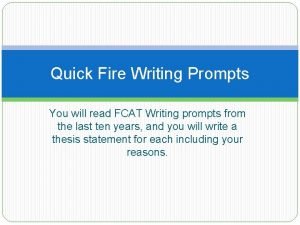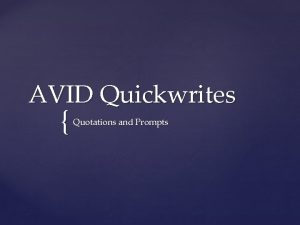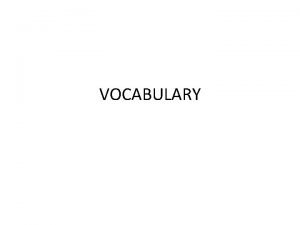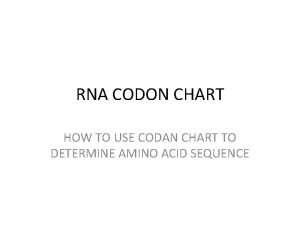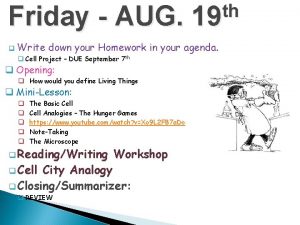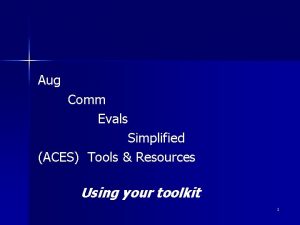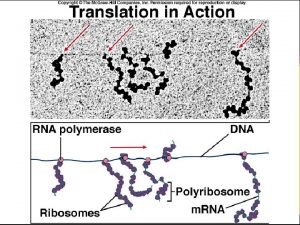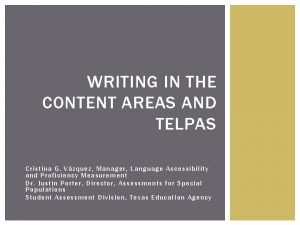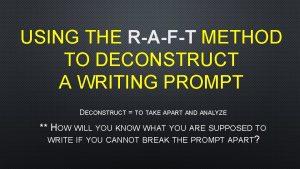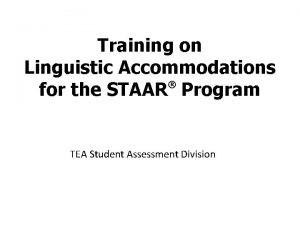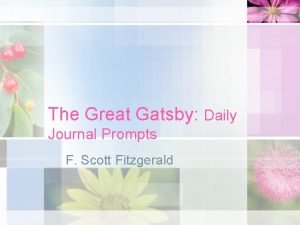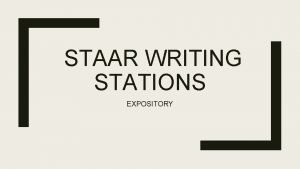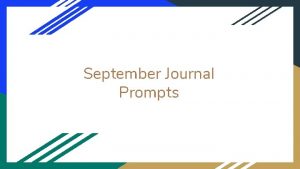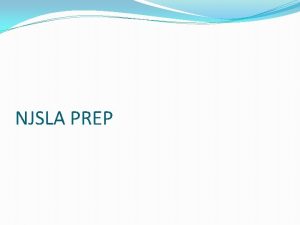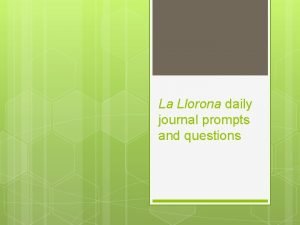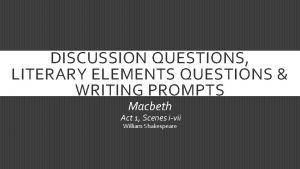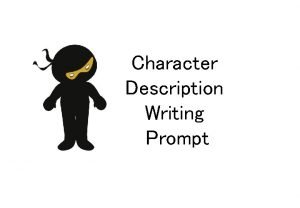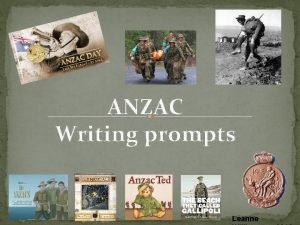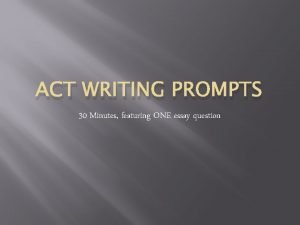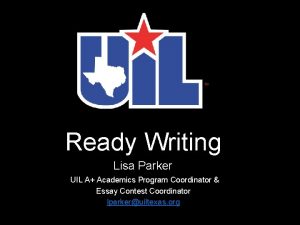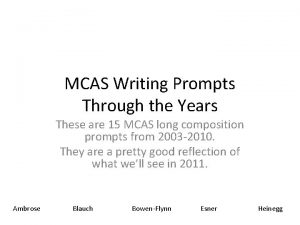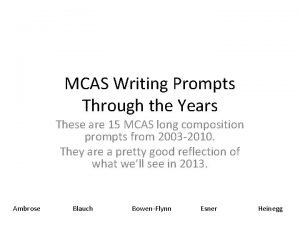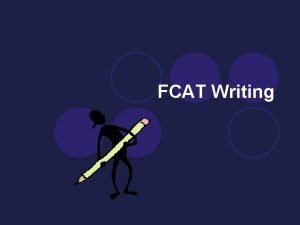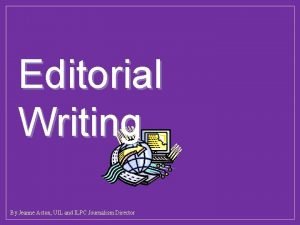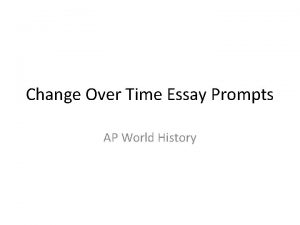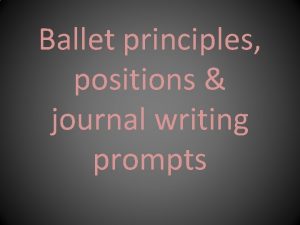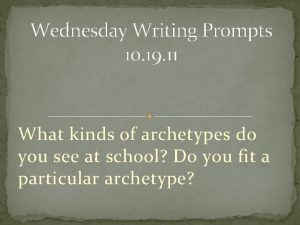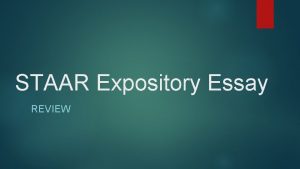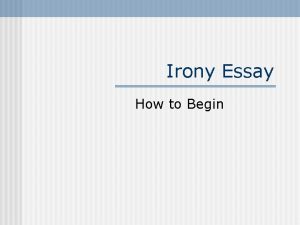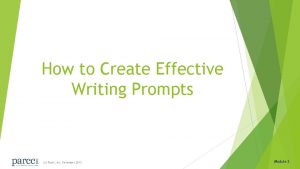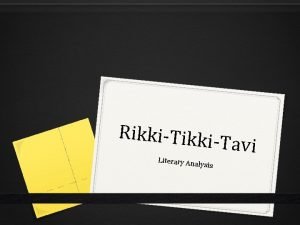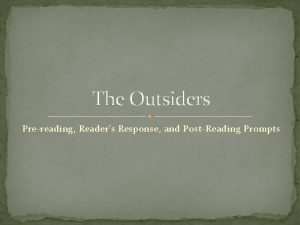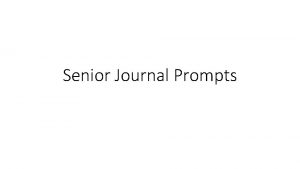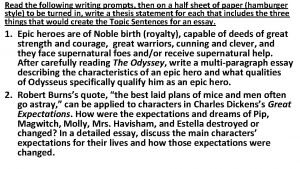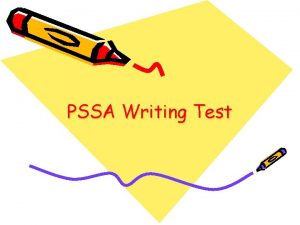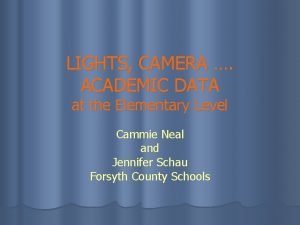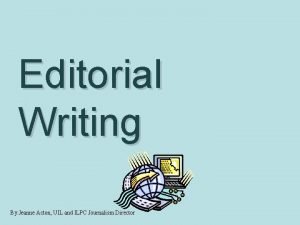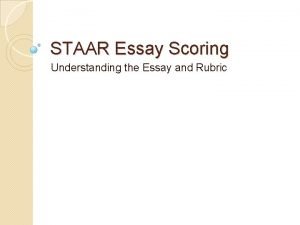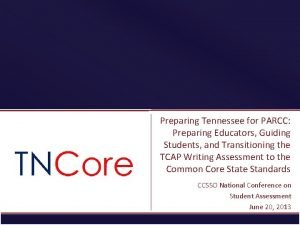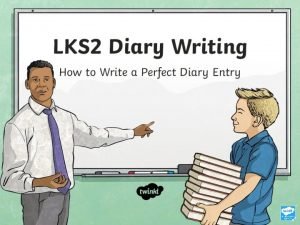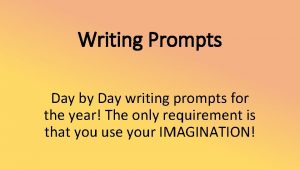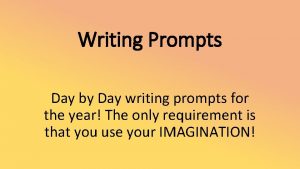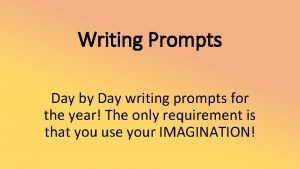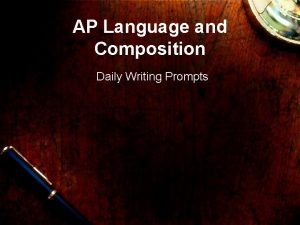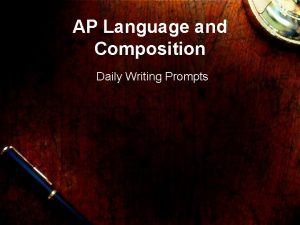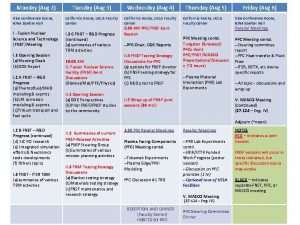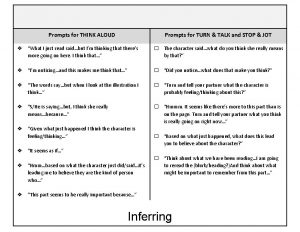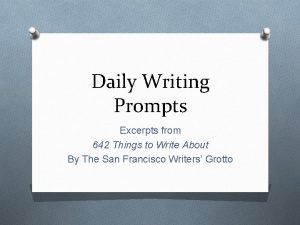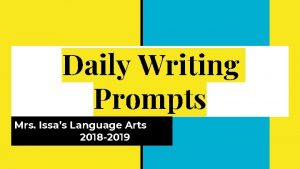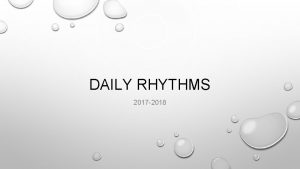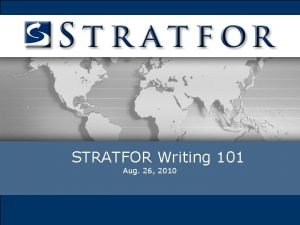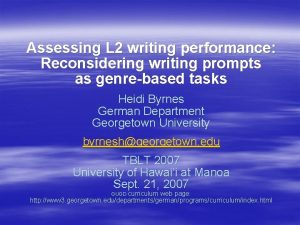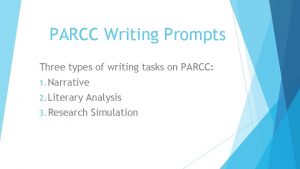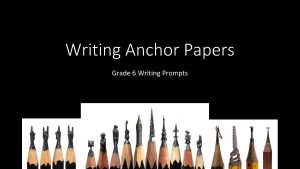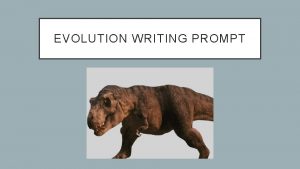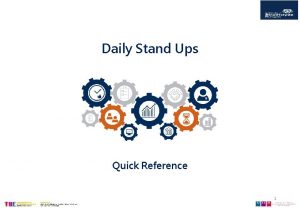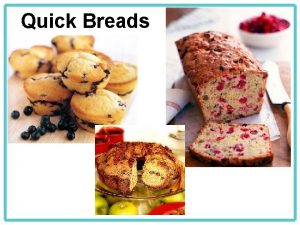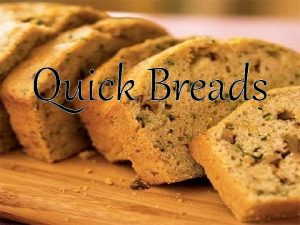Writing II Daily Prompts Aug 11 2010 Quick

















































- Slides: 49

Writing II, Daily Prompts Aug 11, 2010

Quick. Write and Daily Grammar: ✤ Describe the classroom in 3 -4 continuous sentences using 1) Your perspective as a student. 2) The perspective of an ant on the floor.

Identify the italic parts of speech Page 48 “Elements of Lang 5 th Ed. ” ✤ ✤ ✤ For each sentence in the following paragraphs, write each italicized word or word group, and ell how it is used - as a noun, pronoun, adjective, verb, adverb, preposition, conjunction, or interjection. After months [1] of drought, the [2] storm clouds build up in the [3] sky and the torrential deluge [4] begins. [5] Well, it is April in India, the [6] monsoon season. In India [7] and neighboring Bangladesh, the monsoon [8] usually continues from [9] late spring to early fall. [10] During that time, [11] it brings heavy rains [12] that are beneficial to the crops, but [13] some monsoons [14] can be deadly if their [15] rains are abnormally heavy. Monsoons are created [16] when there is a great difference [17] between the temperatures of hot air over the sea and cold air over the land. [18] Southwesterly winds carry warm, moist air up from the Indian Ocean and [19] collide with cooler air over the landmass. [20] The result is a downpour that can last for weeks.

Unit Overview: ” ? t r A s i What “ “Is poetry a n art form? Why or Wh y Not? ” ”? r e v i rece r p p a n to r a e l an I c w o “H y r t e o p e t a eci “ d o o g a e , to b Why do people w rite and read poe try?

Unit Section 1: Building your Repertoire ✤ Five Key Reading Skills: ✤ Interacting with the text ✤ Making connections ✤ Exploring multiple perspectives ✤ Focusing on language and craft ✤ Studying an author

Conversations with Poetry

“Introduction to Poetry” By Billy Collins I ask them to take a poem and hold it up to the light like a color slide or press an ear against its hive. Respond to the Text: I say drop a mouse into a poem and watch him probe his way out, How does the poem make you feel? How do or walk inside the poem's room you think Collins generates these feelings in and feel the walls for a light switch. you? Identify words that trigger this emotion. I want them to waterski across the surface of a poem • Collins demonstrates several ways to interact waving at the author's name on the shore. with a poem. List them. What does each new But all they want to do method add that’s different than the others? is tie the poem to a chair with rope and torture a confession out of it. They begin beating it with a hose to find out what it really means.

Unit Overview: ” ? t r A s i What “ “Is poetry a n art form? Why or Wh y Not? ” ”? r e v i rece r p p a n to r a e l an I c w o “H y r t e o p e t a eci “ d o o g a e , to b Why do people w rite and read poe try?

Quick. Write and Daily Grammar: 1) Quickwrite: Describe what ‘hope’ is by using a metaphor (compare hope-which is an abstract nount- to a concrete noun without using “like” or “as”). **BONUS: “extend” your metaphor by showing how the properties of the concrete noun can reflect the properties of the abstract. For example: Racism is a poisonous snake. **Beware it’s first bite. 2) Grammar: Read pp 55 -56 (up to “adjective or pronoun? ”) then 57 (beginning with “adjective or noun? ”) through 58, and complete exercise 3, #1 -5

Luck. Langston Hughes I don’t really believe in luck, but I’ll hear what he says. I think Hughes was an African American poet in NYC in the 1920 s. Research him a bit. What did luck have to do with his life? So. . . Whoofiswhat? it that’s sitting thea table of joy? A crumb Luck? Is at that metaphor? This is definitely God? a metaphor. . . is this positive or negative? Affluent people? This makes it feel Sometimes a crumb falls like we’re animals begging at the dinner From the tables of joy, table. . . I am sure I like(before this image. Sometimes a bone Maybe this has to do with thenot time period the civil Is flung rights movement, which gave rights to minorities like “flung” seems to be specially chosen here. It African Americans. . . maybe he was saying that “white has an air of disdain, I think. This reminds To some people” sometime left crumbs or threw bones to minorities me of the phrase “throw me a bone” which Love is given, . . . To others means “give me a break. ” Only heaven. Love? Where does this come in. . . I thought we were talking about luck. Are they related? Does this theory help me understand the second stanza? I don’t understand this part. . . “Only? ”

Emulating. . . • What are some words or phrases that describe luck to me? • What are some colors, animals, objects, or other concrete nouns I can compare luck to? • How does my understanding of luck compare to Hughes’? Hughes’ Description of Luck “tables of joy” luck is like love My Description of Luck Lightening Flash Drought vs. Rainstorm Pillows Whiteness

Responding in Poem form ✤ Short lines with strong images ✤ Two short stanzas ✤ Start with “Sometimes” and “To some people”

Luck Mr. Moore ✤ ✤ Sometimes luck rolls in in billowing thunder clouds Lightning streaks the sky as big drops of fortune hurl down To some people, playing in the rain is for fools. They prefer to stay dry under their fancy umbrellas.

Becoming an Active Reader (interlude) ✤ Read together pages 225 - 228. ✤ ✤ How does “responding to the text” help demonstrate the qualities of an active reader? In this next section, we will explore a second tool for active reading, called: “Making Connections”

Unit Section 1: Building your Repertoire ✤ Five Key Reading Skills: ✤ Interacting with the text ✤ Making connections ✤ Exploring multiple perspectives ✤ Focusing on language and craft ✤ Studying an author

How to Become and Active Reader

First Reading. . . Read it, drink it, explore it.

“Identity” Julio Noboa Polanco em be flowers, always watered, fed, guarded, admired, but harnessed a pot of dirt. I'd rather be a tall, ugly weed, clinging on cliffs, like an wind-wavering above high, jagged rocks. To have broken through the ce of stoneto live, to feel exposed to the madnessof the vast, eternal To be swayed by the breezes of an ancient sea, carrying my soul, my beyond the mountains of timeor into the abyss of the bizarre. I'd rather seen, and if, then shunned by everyonethan to be a pleasant-smelling , growing in clusters in the fertile valleywhere they're praised, handled, d pluckedby greedy human hands. I'd rather smell of musty, green hthan of sweet, fragrant lilac. If I could stand alone, strong and free. I'd rather be a tall, ugly weed.

✤ Write down your initial response to the poem.

Second Reading. . . Have a Conversation w/ the poem. (This uses LESSON 1: Interacting with the text!)

On your own. . . ✤ Underline any words with which you are unfamiliar. ✤ ✤ Look them up. Note multiple definitions. . . which one or ones are being used in this poem (note that a poem can select a word with more than one meaning on purpose!) Underline, highlight, or put a star by lines that you think are important, intriguing, or moving to you. ✤ Make notes in the margins or on the lines about why you are marking this line, word, etc. What makes it stand out? Feel free to write out QUESTIONS for the poem (e. g. “why would you want that? ”) and if questions are answered later, draw a line connecting the question to the answer.

On your own. . . ✤ Generate questions to ask throughout the poem ✤ Go beyond “huh” or “I don’t understand this” Frame GOOD questions. E. g. , (notice how these questions are BRINING something to the text as well as asking something of it) ✤ ✤ “Why does the author use this word? Does it have special significance to the meaning of the poem” “The other seems to be implying that. . why does he feel that way? ” “Why does the author repeat this line here? What effect does it have on my understanding of the poem? Does it connect any ideas to elsewhere in the poem? Write down what you think the poem is about / what the poem is trying to say (try to go beyond the immediately obvious)

Sharing. . . Please share what you have underlined with the person sitting beside you. What words or phrases have you underlined? Why?

Third Reading. . . Connecting to the Poem (This uses LESSON 2: Making Connections!)

Three Methods: ✤ Mark the text and annotate Blah blah ✤ Mind Map ✤ Chart

Annotate! ✤ Use the margins and the lines to make notes about how you can relate to aspects of the poem. Use phrases like: “This is like. . . ” or “This reminds me of. . . ”

Mindmap! Uniquenesse s I like about myself Ways I am Unique Importance of Uniqueness in my life Identity means accepting the ways in which I am unique Important people who have been unique

Chart! Connections to world Connections to other events/issues/places/ Connections to You situations beyond you texts and your life

Which method? ✤ Which of the three methods did you like best? Why? ✤ Would different methods work better in different situations? Explain.

Homework: ✤ ✤ ✤ Complete the exercises in your daybook from page 13 -15. For the page 15 exercise, think of someone who has impacted you in a similar way to the way which Aunt Sue impacts the child in the poem (this requires some analysis!). Write a short paragraph about this person, explaining the connection you feel and how it affects the way you live your life. In your paragraph: Highlight all adjectives used, including at least 2 STRONG adjectives. Use and underline at least one metaphor (which utilizes a concrete and abstract noun), circle all adverbs you use. After you do this, reread the poem. Do you understand it on a deeper level now?

Bellwork: Listen to the music ✤ ✤ What do you notice about the beat, the emotions evoked, how it makes you move? What kind of music is it? As we’ve seen, there is connection between music and poetry. . . if you were to try to write a poem in the “style” of blues, what kinds of devices do you think you would want to use? Why?

What is an aspect? ✤ ✤ ✤ When exploring a poem, we are “unpacking. ” What exactly is it that we unpack? Aspects! As we look through poetry for theme(s), devices, sound effects, imagery, use of color, personification, mood, musical quality, form, etc. . . we are looking at many different aspects! As we read poems, one reading = one aspect. If you are focused on one aspect, but notice another. . . make a note and come back to that in another reading. The first and last readings take the poem as a whole. The more aspects a poem has, the more readings it will need to be thoroughly unpacked!

Readings: 1. Holistic impression *****BEGIN UNPACKING******* 2. Interaction + Understanding (ideally: find a theme) 3. + Aspects (one each reading) ******PUT IT BACK TOGETHER******* 4. Holistic impression

The Weary Blues - 7 Readings! Langston Hughes ✤ Read it! ✤ Read it and interact with it! ✤ Read it and focus on the aspect of word choice. ✤ Read it again, focusing on sound effects + their impact ✤ Alliteration ✤ Assonance ✤ Read it again, focusing on repetition ✤ Listen to it, focusing on connection to blues music ✤ Read it all as a whole

Aspects and “The Weary Blues” ✤ How many aspects did we examine? ✤ How many aspects per reading? ✤ Are there any other aspects you can think of for examining this poem with?

Task: Writing a Paragraph Response ✤ ✤ Decide on an aspect of the poem you wish to write about. It cannot be the same aspect as anyone else in your table group. Your homework: ✤ ✤ Fill out the chart on page 20. Write a paragraph which focuses on the aspect you chose, giving information about the aspect in the poem, and explaining what this aspect adds to the poem as a whole. (Does it help us understand theme? Develop the mood? Help establish a connection to something? )

Bellwork: ✤ SILENTLY ✤ Take out a piece of paper (or use your notebook) and write down what you think a paragraph needs to be considered “excellent. ” Go beyond just listing one-word ideas - develop these. We’re looking for not just “good” but “excellent” work. What would it include?

What makes a good paragraph?

Bellwork: ✤ ✤ Silently Identify what you think the “theme” of the following poem (Grass - by Carl Sandburg) is:

Pile the bodies high at Austerlitz and Waterloo*. *battlefields in the Napoleon Wars Shovel them under and let me work— I am the grass; I cover all. And pile them high at Gettysburg* *battlefield in the American Civil War And pile them high at Ypres and Verdun*. *major battlefields of WWI Shovel them under and let me work. Two years, ten years, and the passengers ask the conductor: What place is this? Where are we now? I am the grass. Let me work.

Today’s Objectives: 1. Practice finding theme 2. Introduce/Review onomatopoeia + rhyme 3. Review sound effects + paragraphing in preparation for the test

Onomatopoeia ✤ A sound effect used in poetry in which a spoken word makes the sound of the thing to which it refers. ✤ ✤ E. g. “Sizzle” or “swish” or “thump” or “clang” or. . . When used in poetry, it helps intensify the atmosphere by appealing to your sense of hearing in bringing you into the world of the poem.

Rhyme ✤ ✤ Rhyme occurs when the final syllable of a word matches the final syllable of another word. E. g. “Night + Light” “Steal + Automobile” “Almost Rhyme” occurs when two words are very close to rhyming, but do not make a perfect connection. E. g. ✤ ✤ My father worked with a horse plough, His shoulders globed like a full sail strung Between the shafts and the furrow. The horses strained at his clicking tongue. Rhymes usually occur at the end of lines, but “Midline” rhyme occurs with words in the middle of a poetic line. E. g. ✤ Once upon a midnight dreary, while I pondered weak and weary, Over many a quaint and curious volume of forgotten lore, While I nodded, nearly napping, suddenly there came a tapping, As of some one gently rapping, rapping at my chamber door.

Rhyme ✤ A “rhyme scheme” occurs in a poem in which a pattern of end-line rhyme is repeated. ✤ ✤ My father worked with a horse plough, His shoulders globed like a full sail strung Between the shafts and the furrow. The horses strained at his clicking tongue. A B If the pattern is consistent, it can give the feeling of one or more of the following: control, order, cheerfulness, consistency, etc. If the pattern is erratic, it can give the feeling of one or more of the following: lack of control, disorder/chaos, depression, confusion, hyperactivity, etc. When a rhyme is brought back at some point in a poem, it sometimes serves to connect ideas from one part of the poem to another.

The Sound Collector ✤ First, attempt to find a theme. . . what is the poem trying to SAY? ✤ What examples of Onomatopoeia do you see? ✤ ✤ What effect do they have on theme/mood/ tone of the poem? What examples of Rhyme? In what scheme? ✤ What effect does it have on theme/mood/tone of the poem?

Finding Theme ✤ Read a poem as many times as you need to to extract a theme. Treat your theme as a “theory” to be tested in subsequent readings. Know that some poems have multiple themes! ✤ “Grass” ✤ “Sound Collector” ✤ “Follower”

Sound Effect Repertoire ✤ Alliteration ✤ Assonance ✤ Consonance ✤ Onomatopoeia ✤ Rhyme

What makes a good paragraph? ✤ Content: ✤ ✤ Organization: ✤ ✤ Focused, thorough, deep (analysis, not summary) Connects well to theme, includes core features of a good paragraph ✤ Topic Sentence ✤ Support (use examples!) ✤ Transition Language: ✤ Good use of vocabulary, idiom, grammar, and punctuation

WARNING: Test on Wednesday! ✤ You will be given a poem COLD and will be asked to find a theme, and sound effects in the poem that help support/develop the said theme. You will write a response paragraph in which you explore the aspect of sound effects in the poem using examples and analysis.
 Students to wring more from
Students to wring more from Avid quick write
Avid quick write Quick find algorithm
Quick find algorithm Collision forces quick check
Collision forces quick check Words with root words
Words with root words Translation
Translation Codon chart
Codon chart Kaugnayan sa kaligirang pangkasaysayan
Kaugnayan sa kaligirang pangkasaysayan Aug q
Aug q Aug comm device
Aug comm device Transkripsjon og translasjon
Transkripsjon og translasjon Workkeys writing prompts
Workkeys writing prompts Telpas samples
Telpas samples What does raft stand for
What does raft stand for Linguistic accommodations
Linguistic accommodations Writing prompts for the great gatsby
Writing prompts for the great gatsby Staar expository writing prompts english i
Staar expository writing prompts english i September writing prompts
September writing prompts Njsla prep
Njsla prep Fahrenheit 451 writing prompts
Fahrenheit 451 writing prompts Released writing staar
Released writing staar Macbeth act 1 discussion questions
Macbeth act 1 discussion questions Character description writing prompt
Character description writing prompt Anzac day persuasive writing
Anzac day persuasive writing How to write a 5 paragraph essay in 30 minutes
How to write a 5 paragraph essay in 30 minutes Uil ready writing winning essays
Uil ready writing winning essays Mcas writing prompts
Mcas writing prompts Mcas writing prompts
Mcas writing prompts Gsp writing prompts
Gsp writing prompts Ways to start a sentence
Ways to start a sentence Editorial writing examples
Editorial writing examples World history essay prompts
World history essay prompts Dance writing prompts
Dance writing prompts Wednesday writing prompts
Wednesday writing prompts Staar test writing prompts
Staar test writing prompts Verbal irony essay
Verbal irony essay Parcc writing prompts
Parcc writing prompts Deconstructing writing prompts
Deconstructing writing prompts Canterbury tales writing prompts
Canterbury tales writing prompts Rikki tikki tavi writing prompts
Rikki tikki tavi writing prompts The outsiders journal prompts
The outsiders journal prompts Journal prompts for seniors
Journal prompts for seniors Odyssey writing prompts
Odyssey writing prompts Pssa writing rubric
Pssa writing rubric Aimsweb writing prompts
Aimsweb writing prompts Uil editorial writing prompts
Uil editorial writing prompts Staar essay
Staar essay Tcap writing prompts
Tcap writing prompts Quick writing activities
Quick writing activities Write a diary entry
Write a diary entry
